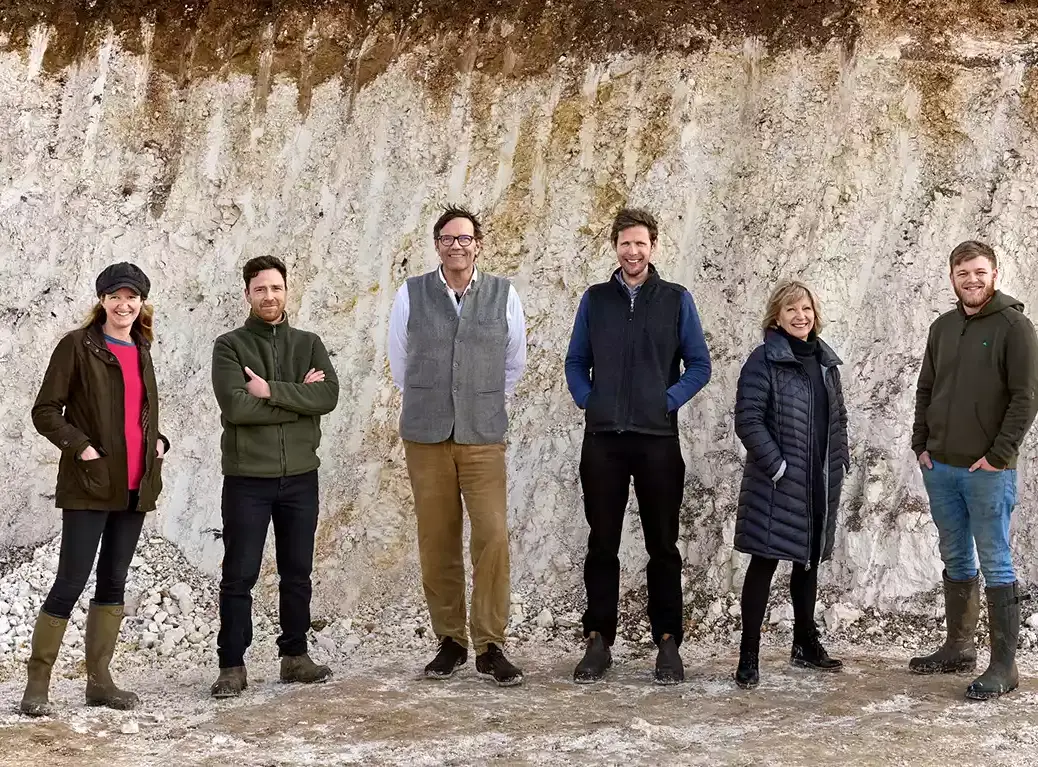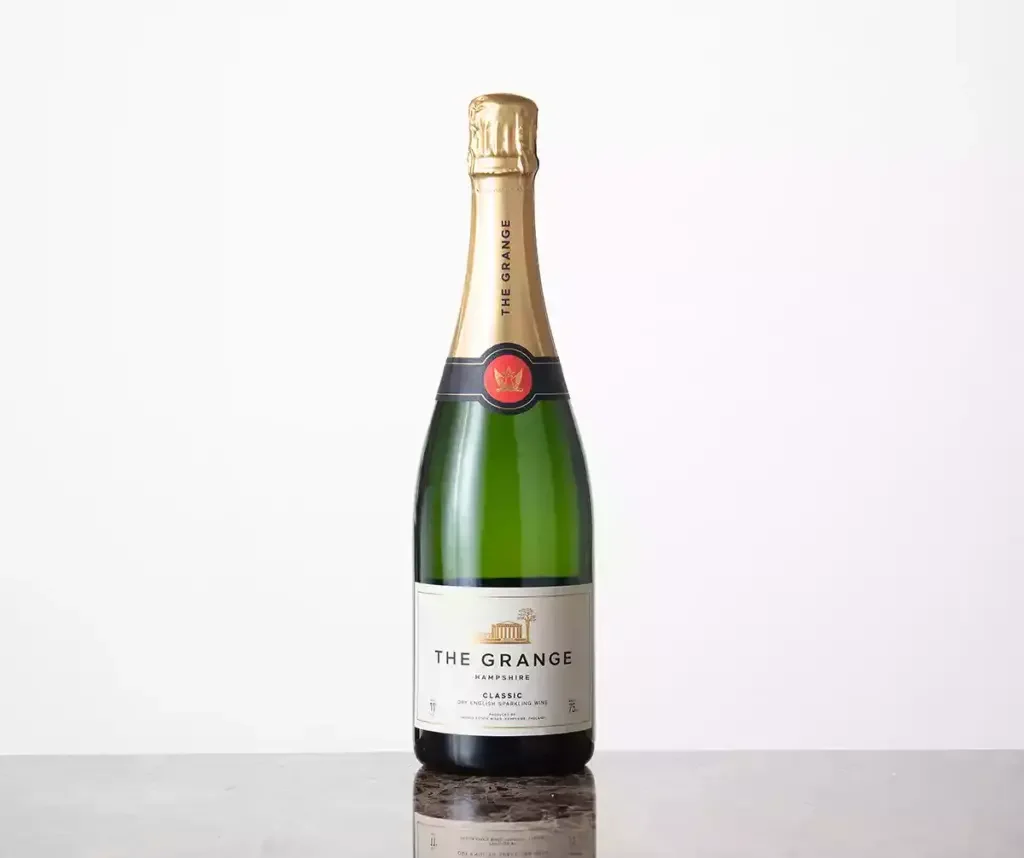
A relatively new face on the English wine scene, The Grange is the work of a multitalented family who have moved into wine on their estate in a beautiful corner of Hampshire.
I can do media,” says Zam Baring; “Mark can do money, Rose and Lucy get out selling. The only thing we lack is any experience of wine.” He’s both joking and not. The Grange is a young producer, and the Baring siblings are newcomers to wine.
However, the Barings are not amateurs. Mark—8th Baron Ashburton—runs the estate, in Hampshire, which also stages the superb Grange Festival of opera each summer; he also has a career in asset management. Rose has been running a highly rated independent publisher, Eland Books, while Lucy founded Vaughan, which is where you go for top-of-the-range lighting. And Zam (christened Alexander), who used to work in television production, is Mark’s partner in the arable farming business and runs the wine company.
It all began as part of the need of startup wine producers to scale up their production to a certain level. Nick Coates and Christian Seely, the dynamic duo behind Coates & Seely (see WFW 77, pp.172–75), were looking for places to plant vines on the chalky clay of Hampshire, and they persuaded the Barings to put in 25 acres (10ha) of Chardonnay, Pinot Noir, and Pinot Meunier, four clones of each. As Coates says of his venture, “The main difficulty was in finding the perfect site, because everything around is owned by big farming families or big companies, and they won’t sell. But if you suggest to them that they plant a sparkling vineyard…” Those big estates, of which the Barings’ is one, don’t sell land, and they certainly don’t sell the land that a wine producer might want. However, the idea of planting a vineyard can tempt them to put forward the right sort of site. Which, since the Barings wanted to diversify, is what happened.
So, here we find ourselves in a particularly beautiful part of Hampshire, where satnav is likely to take you not to your destination but to an unnamed road in a warren of unnamed roads, to the polite bafflement of everybody at The Grange, who know exactly how to get there. (Getting to the opera festival is a satnav drama every year. But enough of that.)
It is not, so far, the shiniest or most visitor-oriented of English producers, but there is a new winery. As ever, this is far bigger than they need—it can handle 200 tons, and tops for The Grange will be 75 tons; they aim to fill it with contract winemaking for others, though probably no more than three to five at a time, in order to treat them with the individuality they need. Building the winery was expensive; there was, says Zam, a 40 percent increase in costs between planning, pre-Covid, and actually starting. “But having our own winery is brilliant. Emma Rice at Hattingley Valley was making the wine,” and Emma is top-notch, but now “the grapes, instead of disappearing into a tractor and you never see them, come here, and it’s so exciting seeing the juice coming out.”
But we’re jumping ahead. Let’s go back to the beginning.
Knowing the direction of travel
The vines were planted in 2011, in the southwest corner of this 3,500-acre (1,400ha) estate, on a spot called Burges Field: a south-facing slope with about 6in (15cm) of topsoil at the top and double that at the bottom. The soil analysis judged it very good for sparkling. With hindsight, says Zam, planting the bottom of the slope wasn’t a great idea, because there’s 7.2°F (4°C) difference, and the bottom vines get frosted. The rows run downhill, and they have bougies to ameliorate frost; however ideal the soil might be, it’s a cold spot.
Accordingly, it’s late-ripening. “At Hattingley, we were always the last to arrive,” says Zam. “We’re three weeks later than some places in Kent. We get lots of rain here, though it drains very well. And there’s lots of vigor.”
They try to be as regenerative as possible, and at one point they stopped mowing or cultivating about 20 rows. However, those vines became outcompeted by grass, and the canopy on them has halved. “But there was no mildew there in 2020 because the air flow was so good.” They will go back to cultivating those rows to get the yield back up: “We are just at the start of understanding how to manage our soil.” They use no herbicides at all and reduce all sprays as much as possible; they will work on an organized regenerative approach, probably with rotational cover-crop sowing.
The plan was for Coates & Seely to make the wine. But then, they decided not to do contract winemaking anymore; since the Barings didn’t want to throw in their vinous lot with Coates & Seely, they were on their own. There were (and had been) various advisors: There was the viticulturalist with lots of experience in Italy, who was “slightly surprised by all the dock leaves that took over the inner tubes”; there was the “very efficient, very organized” Phil Norman; there was Peter Hayes from Australia; and there was the famous consultant “who laughed when I wanted to have an input, which was less than satisfactory.”
After a beauty parade of different possible contract winemakers, they chose Emma Rice, then at Hattingley, who asked what style they wanted to make. So they had a tasting of about 25 sparklers from round the world. “We had very novice palates… I am still at the stage where the base wines taste disgusting. It’s a crash course in teaching oneself.” Krug came top: “None of us had ever tasted it before.” Emma’s reaction, brave in the circumstances, was: “I’ll see what I can do. At least I know the direction of travel.”
The first bottles were opened in 2018, and the idea was to serve the wine at the Grange Festival, which made Michael Moody, COO of the festival, rather nervous. According to Zam, “When he tasted it, an enormous expression of relief spread over his face. He said, ‘Thank God it’s not shite.’”
And funnily enough, it’s not. It’s classically fresh and balanced, very much in the lemon-shortbread spectrum of flavors, with plenty of tension and a savory finish. They favor doing the malolactic for most wines. The pink (called Pink) has a steely core under some opulent fruit and a touch of oak. There’s also the occasional still wine, but no more than occasional. The barrels are ex-Burgundy, from Tonnellerie de Champagne, and the wine so far has been nearly all Vintage, but sold as Non-Vintage because that is the way they have always wanted to go. (“The cost of producing 750 labels for the first wine prompted our decision to go Non-Vintage,” says Zam.) There is a large solera reserve, which contains wines from 2015 onward; part of the Classic blend goes into it every year.

Understanding The Grange vineyard
Harry Pickering has views on this, however. Harry is now the in-house winemaker; coming from Gusbourne, where he worked with Charlie Holland, he arrived at The Grange in June 2021. He would like to keep the reserve wines separate, perhaps by grape variety; having more blending components is the aim. Practicality can be a problem here; it’s difficult to keep fewer than 1,200 liters in good condition, says Zam, “and that’s quite a lot of our production at this stage.” It will be easier as volumes increase.
When Harry arrived, they did a tasting of everything they had—everything under cork, everything on lees, everything in the cellar. “We’d never done that before,” says Zam. And now, says Harry, they’ll be experimenting year on year, starting with the new winery this year (£2 million and more: £1.7 million for building it, and about £600,000 for the kit) and building on what Hattingley has done. What might change?
Well, Zam suspects that Pinot Meunier might be the best suited to the terrain—he prefers the English word over “terroir.” “I’m not quite confident in Chardonnay yet.” “Chardonnay is a long-term proposal,” says Harry, “it needs a long time on the lees. But we can’t change everything at once. We’re vineyard-focused, and we can develop a sense of place, but not at the expense of compromising the fruit.”
Zam says that his son is obsessed with natural wines and is interested in the yeasts that occur naturally. “Harry let me ferment three barrels naturally, and they were an interesting blend element; they had a very different flavor. I’m interested in using our own yeasts, but not if they screw up the wines.”
And really, says Harry, the next five years will be spent understanding the vineyard. But what a start they have made. ▉






